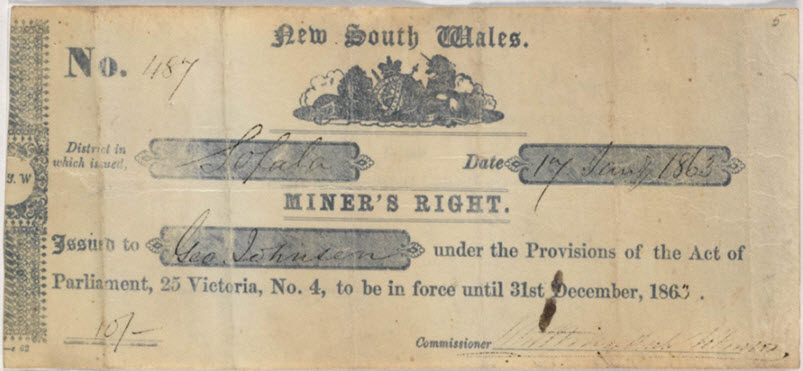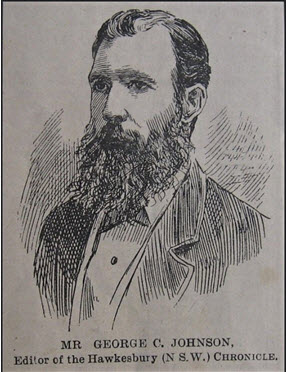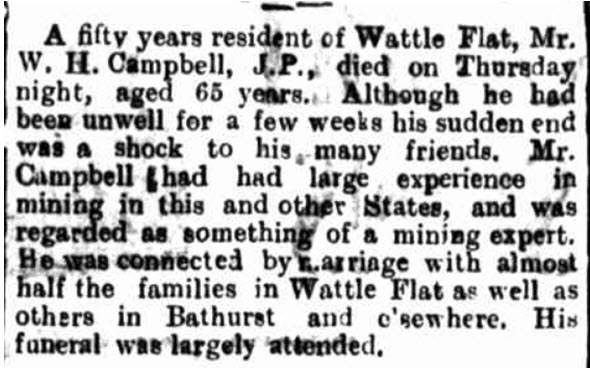4. Johnson & Campbell – talent at Solitary
Two talented men are notable for shaping the early history of the Solitary Mine.
George C. Johnson aged 24 had a short but rich connection with the Solitary Mine before engaging with a career as a renowned Sydney newspaper columnist. In 1915 he wrote in detail of his Solitary Mine experiences. William H. Campbell in contrast, arrived in Wattle Flat aged 12 and spent the rest of his life (54 years), in Wattle Flat. He led the investigation of quartz reefs in the Big Oakey Creek area and was a catalyst for the 1872 gold rush in Wattle Flat. More importantly, he operated the Solitary Stamp Battery (then known as Campbell’s machine) during the 1872 gold rush period until 1881. He lived here next to the Solitary Mine.
George C. Johnson (1839 – 1924) (spent 1 year in Wattle Flat)
Johnson arrived in the Turon River alluvial diggings aged 22 in 1858. He was recognised as an astute & hard working young man and was offered a job at the Solitary underground reef mine. He spent a full year (1862-63) working underground and experiencing life in early Wattle Flat.
The Solitary Mine manager was Alex Cooper, who could be very intimidating. Of the dozen mine workers typically employed in this mine, there was a high turn-over but surprisingly George & Alex got on well together. The mine then had 3 shafts with ladderways. The deepest workings were over 50 metres down and became inundated with groundwater. A horse was used to hoist the broken quartz rock out of the mine.
In the process of working underground, the miners each created a shallow drillhole which was then filled with black-powder, & had a fuse attached. After the crew exited the mine, one miner remained to light the fuses before making a hasty exit. As the mine worked deeper levels the groundwater inflow became increasingly difficult to manage. Bailing using a bucket hoisted by the horse was carried out at night, much to the annoyance of George Morehouse who lived in the house below the mine.
Alex the mine manager owned the hotel across the road called the Australian Inn. The publican was John Gorrick a retired famous boxer (Bungaree). George had a room at another hotel, the Diggers Rest managed by Sam Jagoe a short distance up the road. Rest & recreation involved an assortment of games & sports. Cricket was very popular and the Solitary mine area had its own cricket team named the United Miners. They regularly played against another cricket team based at the northern end of Wattle Flat named the Young Australians.
After leaving the goldfields in the mid 1860’s, George settled in the Windsor area, married & raised a family. He developed skills as a journalist & in 1881 started the Hawkesbury Chronicle newspaper. This paper merged with other papers but George continued writing columns in newspapers for the rest of his life. His articles were usually signed with GCJ or his pseudo name Paul Twyford and can be found online today in Trove (digitized newspapers).

George C Johnson’s miners right-Sofala -1863

George C Johnson – Editor of the Hawkesbury Chronicle 1881-1888

Notice on the death of W H Campbell J P in Wattle Flat, 1909 (from National Advocate 10 May 1909)
William H. Campbell (1844-1909) (he spent 54 years in Wattle Flat)
William was the youngest son of an Irish tailor come publican. He arrived in Wattle Flat aged 12, with his parents & older sisters. The family take on the licence for the Diggers Home Hotel in Wattle Flat. Something inspires William to take a very keen interest in quartz reefs and the milling of quartz rock. In 1869 at the age of 25, he operated the Solitary stamp battery for owner Mr T C Breillat a rich Sydney merchant. In 1871 together with several others he takes up quartz mining claims on a ridge west of Big Oakey Creek. This leads to the discovery of reefs comparable in richness to those being mined at Hawkins Hill, Hill End, and triggers a reef mining gold rush for Wattle Flat.
Over the following years he becomes a highly respected member of the Wattle Flat community. In 1895 he represented the Sofala-Wattle Flat district at a national mining conference, and for several years he presided over civic meetings at Wattle Flat. He died in Wattle Flat in 1909 aged 65.